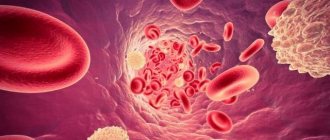Chronic myeloid leukemia
(CML) is one of the types of leukemia with slow progression.
The cells formed during leukemia are immature and have a longer lifespan than mature (normal) leukocytes. As the disease progresses, immature cells accumulate in the bone marrow and enter the peripheral blood, displacing normal hematopoietic cells.
Men suffer from CML somewhat more often than women. The average age of patients is 30-70 years.
Causes of myeloid leukemia
The reasons for the development of CML is the exchange of sections of chromosomes 9 and 22. The new chromosome that forms in this case is called the Philadelphia or Ph+ chromosome. The Philadelphia chromosome was discovered in 1960 by Peter Nowell and David Hungerford in Philadelphia. It got its name from the place where the discoverers worked. The Philadelphia chromosome (Ph+) contains an abnormal gene called BCR-ABL. This gene is responsible for the formation of the abnormal protein BCR-ABL, which causes excessive production of abnormal white blood cells.
Who is at risk?
- Men.
- People over 60 years of age.
- People who smoke.
- People who have had radiation therapy or chemotherapy (this happens with other forms of cancer).
- People who have been exposed to radioactive radiation.
- People suffering from Down syndrome and other genetic disorders.
- People who suffer from myelodysplastic diseases (this is the name of a group of chronic diseases in which the bone marrow stops producing a sufficient number of full-fledged blood cells).
Symptoms of myeloid leukemia
Symptoms for this disease are not specific: weakness, loss of appetite, weight loss, sweating, fever, itchy skin, bone pain, fatigue, pale skin, tachycardia, bleeding with minimal abrasions and bruises.
When contacting a therapist with this complaint, the first thing you might think of is a viral disease (acute respiratory infection, ARVI, influenza, etc.). Only based on the results of a complete blood count (CBC), a blood disease can be suspected. The blood test must be deciphered by a specialist, because With viral diseases, there are also deviations in the results. If the therapist sees from the blood results that the changes are not characteristic of a viral disease, you will be referred for a consultation with a hematologist.
Chronic myeloid leukemia
The treatment method for CML depends on the stage of the disease and the patient’s health status.
Drug therapy for chronic myeloid leukemia
Drugs have been developed that can suppress molecules that trigger the development of leukemia and the gene associated with it. These drugs are often used in the early stages of CML. They are a better treatment option than chemotherapy and biological therapy. The following medications are used to treat chronic myeloid leukemia:
— Imatinib (Gleevec, Genfatinib, Filachromin, Neopax, Imatinib, etc.)
— Dasatinib (Sprycel)
- Nilotinib (Tasigna).
— Bosutinib (Bosutinibum).
Chemotherapy for chronic myeloid leukemia
Chemotherapy is the use of drugs to kill cancer cells. Chemotherapy drugs can be given in various forms: tablets, injections, or catheter administration. The drugs enter the bloodstream and travel throughout the body, killing mainly cancer cells, but also some healthy cells.
Biological therapy
This treatment for CML is still being tested in clinical settings. Treatment involves the use of drugs or substances that are used to increase or restore the body's natural defenses against cancer. This type of therapy is also called biological response modifier therapy. Sometimes very specific (monoclonal) antibodies are used that are designed to suppress leukemia cells. Currently, monoclonal antibody therapy is limited to clinical trials and is not available in Russia.
Chemotherapy with stem cell transplantation
Chemotherapy with stem cell transplantation for the treatment of CML is still in clinical trials. Chemotherapy is accompanied by stem cell transplantation (immature blood cells). They will replace the blood-forming cells destroyed by cancer treatment. Stem cells are selected from the blood or bone marrow of a donor and then injected into the patient's body.
Lymphocyte infusion
Lymphocytes are a type of white blood cell. Lymphocytes from a donor are introduced into the patient's body and cancer cells do not attack them.
Surgery for chronic myeloid leukemia
A splenectomy, an operation to remove the spleen, may be performed. It is performed if the spleen is enlarged or other complications arise.
TRANSPLANTATION
Bone marrow transplantation
Because chemotherapy drugs destroy bone marrow cells, a transplant is a truly life-saving treatment for the patient. The goal of a bone marrow transplant is to introduce healthy bone marrow cells into the body while being treated with high doses of chemotherapy drugs (thereby increasing the likelihood of destroying cancer cells and making a full recovery).
Stem cell transplant
Stem cells are cells in the early stages of development that have not yet turned into leukocytes, erythrocytes or platelets. Today, stem cells are obtained from peripheral blood using a special device that allows sorting different types of cells. In such a device, the blood is centrifuged at high speed and separated into its component elements. The process lasts 3-4 hours.
Stem cells are selected and frozen until the transplant procedure. If the transplantation is successful, the stem cells will take root in the recipient’s body, undergo a maturation process, and subsequently form all types of blood cells: leukocytes, erythrocytes and platelets. Transplantation of cells from a donor is called allogeneic transplantation; transplantation of the patient's own cells (usually stem cells) is called autologous transplantation.
Allogeneic transplantation (from a compatible donor)
In allogeneic transplantation, the source of bone marrow cells or stem cells is a donor whose cells have been found suitable for transplantation after a tissue compatibility test. In some cases, the donor may be a relative of the patient, but in principle cells from a stranger can be used if they have successfully passed the compatibility test.
Before the transplant procedure, it is necessary to completely destroy all malignant cells in the patient's bone marrow. For this purpose, cytotoxic drugs are prescribed in high doses and radiotherapy (irradiation of the whole body). The graft is then introduced into the patient's body through an intravenous infusion.
The process of engraftment of transplanted cells takes several weeks. All this time, the patient’s immune system functions at an extremely low level, so during this period the patient must be carefully protected from infections. For this reason, after the transplant procedure, the patient is kept in isolation until his blood test shows an increase in the number of white blood cells. This growth is a symptom of the restoration of the immune system, the engraftment of the transplant and the resumption of the hematopoietic process.
It is important to remain under medical supervision for several months after the transplant procedure to ensure that a condition called graft-versus-host disease is recognized early if necessary. This is a condition in which cells from the transplanted bone marrow attack the patient's body tissue. It may occur within 6 months after the transplant procedure. Graft-versus-host disease can be accompanied by symptoms of varying severity, ranging from mild (diarrhea, rash) to severe (liver failure). Appropriate medications are prescribed to treat this condition. The occurrence of graft-versus-host disease does not mean that the transplant was unsuccessful.
Autologous transplantation
In this procedure, the stem cell donor is the patient himself, who is in remission.
Blood is drawn from a vein in one arm of the patient, passed through a machine that separates the stem cells, and returned to the body through a vein in the other arm.
2. Symptoms of the disease
Possible signs of chronic myeloid leukemia may include fatigue, fever, and increased sweating at night.
.
But all these signs may indicate other health problems, not just myeloid leukemia. But in any case, it is better to consult a doctor if you have the above symptoms, and also if you notice causeless weight loss, pain or a feeling of fullness below the ribs on the left side of the body
. It also happens that chronic myeloid leukemia does not cause any symptoms at all.
Most people with chronic myeloid leukemia have a gene mutation in their bodies,
called the "Philadelphia chromosome". This causes the bone marrow to produce the enzyme tyrosine kinase, which causes too many stem cells to develop into white blood cells (granulocytes). The Philadelphia chromosome is not passed on from parents to children, but develops on its own as a genetic defect.
Visit our Oncology page
Treatment with folk remedies
Since chronic myeloid leukemia is a terrible disease, and the success of therapy depends on the correctness and timeliness of its treatment, you should not use any traditional methods of treatment. Their use, especially when it comes to replacing traditional treatment with folk methods, can ultimately lead to dire consequences.
With the permission of the attending physician, the patient can use general restoratives - for example, herbal teas (melissa, mint, chamomile, raspberry, viburnum, hawthorn, rosehip) with honey. You can also prepare strengthening products based on honey, dried fruits, and nuts.
2. Risk factors for the disease
Risk factors for acute myeloid leukemia are circumstances whose presence suggests the development of this cancer. Identifying a predisposition does not mean that you will sooner or later hear a terrible diagnosis, since the exact reasons that provoke the appearance of leukemia have not yet been established.
The most common factors whose impact on the human body influences the occurrence of oncology include:
- smoking;
- exposure to chemicals: detergents and cleaners, solvents;
- exposure to high doses of radiation;
- use of strong chemotherapy drugs;
- blood diseases;
- congenital syndromes.
Although the cause of acute myeloid leukemia is still unknown, you can take preventative measures to protect yourself from it. For example, stop smoking and minimize exposure to toxic chemicals.
Visit our Oncology page
Diet
Diet for leukemia (blood cancer)
- Efficacy: no data
- Duration: until recovery/lifelong
- Cost of products: 3000-4600 rubles. in Week
During the treatment period, it is important to adhere to recommendations regarding proper nutrition. A proper diet with sufficient content of substances important for the body will contribute to the effectiveness of treatment of the disease. During the treatment of myeloid leukemia, it is very important to prevent deficiency of iron, cobalt, copper, manganese, nickel, and vitamin C. All these components are important for the restoration of blood cells, as well as for maintaining the optimal general condition of the patient. The following products should be included in the diet:
- protein foods - sea fish and seafood, rabbit and poultry meat, egg yolks, offal, dairy products;
- vegetables - greens, peppers, cabbage, legumes, carrots, pumpkin, corn, zucchini;
- fruits - citrus fruits, pears, berries, apples, plums, peaches, apricots, sea buckthorn;
- cereals;
- bran bread;
- honey.
It is recommended to exclude from the diet:
- lamb and beef, which contain refractory fat;
- coffee, tea and other products containing caffeine;
- products with vinegar - canned food, etc.;
- alcohol;
- hot spices.
It is recommended to reduce the amount of fat consumed.
Prevention
There are no specific methods for preventing the disease. In order to reduce the risk of developing chronic myeloid leukemia, it is recommended to follow these rules:
- Regularly undergo preventive examinations.
- Contact a specialist immediately if you experience any warning symptoms.
- Lead a healthy lifestyle - give up bad habits, eat rationally, and regularly practice physical activity.
- Try to limit exposure to hazardous substances at work.
4. Treatment of the disease
Treatment of chronic myeloid leukemia is selected individually for each patient, and generally depends on the patient’s age, the phase of chronic myeloid leukemia, general health and the size of the spleen at the time of diagnosis.
Depending on the phase, treatment for chronic myeloid leukemia may include
:
- Chronic phase of chronic myeloid leukemia
- targeted therapy with a tyrosine kinase inhibitor; high doses of chemotherapy with donor stem cell transplantation; biological therapy (interferon) with or without chemotherapy; chemotherapy; splenectomy; - Accelerated stage-by-stage chronic myeloid leukemia
– transplantation of donor stem cells; targeted therapy with a tyrosine kinase inhibitor; tyrosine kinase inhibitor therapy followed by transplantation of donor stem cells; biological therapy (interferon with or without chemotherapy; high-dose chemotherapy; chemotherapy; transfusion of blood or blood components to replace white or red blood cells to relieve symptoms of the disease; - Blaster phase of chronic myeloid leukemia
- targeted therapy with a tyrosine kinase inhibitor; chemotherapy using one or more drugs; high doses of chemotherapy; transplantation of donor stem cells; chemotherapy as palliative treatment to relieve symptoms of the disease; - Relapse of chronic myeloid leukemia
- targeted therapy with a tyrosine kinase inhibitor; donor stem cell transplantation; donor lymphocytes; biological therapy with interferon.
List of sources
- Abdulkadyrov K.M., Bessmeltsev S.S., Rukavitsyn O.A. Chronic myeloid leukemia. – St. Petersburg: “Special Literature”, 1998.- 464 p.
- Quality of life of patients with chronic myeloid leukemia / M. I. Savelyeva, I. N. Samarina, O. S. Samoilova, etc. // Kremlin. medicine. Wedge. Vestn. – 2012. – No. 1. – P. 60-64.
- Savva N.N. Innovative approaches to the treatment of chronic myeloid leukemia in children / N.N. Savva // Republican Scientific and Practical Center of Pediatric Oncology and Hematology of the Ministry of Health of the Republic of Belarus. Medical news. - 2010. - No. 5-6. — P.12-17.
- Smirnova, O. V. Chronic myeloid leukemia - clinical and immunological features in adult patients / O. V. Smirnova // Acta Biomedica Scientifica. – 2012. – No. 3-2. – pp. 185-189.
Prognosis for myeloid leukemia
Currently, thanks to the use of modern drugs, the life prognosis for chronic myeloid leukemia has improved. With the use of new drugs, life expectancy for chronic myeloid leukemia in 90% of patients is at least 5 years. Most of them remain in normal health 10 years after completion of therapy.
But in general, both the life prognosis for acute myeloid leukemia and the prognosis for chronic myeloid leukemia depend on the stage of the disease. Life expectancy directly depends on the timeliness of the treatment started, as well as the correctness of its tactics.
Tests and diagnostics
To diagnose the disease, it is necessary to conduct a series of laboratory tests, as well as instrumental examinations. A blood test for myeloid leukemia can give the doctor a lot of important information. What kind of blood test for chronic myeloid leukemia needs to be performed and in what sequence is determined by the doctor.
In general, the following examinations are practiced in the diagnostic process:
- General blood analysis. The disease can be suspected if a general blood test reveals a very high level of leukocytes. Levels of platelets, hemoglobin and red blood cells may be reduced.
- The leukocyte formula is determined by a blood smear - in this way the doctor finds out the ratio of leukocytes and also identifies immature cells. Sometimes a microscopic blood test reveals less mature white blood cells that are normally present only in the bone marrow. But often externally circulating leukocytes do not differ from normal ones.
- Biochemical blood test - a number of indicators are determined. Among them, the level of neutrophil alkaline phosphatase, a substance present only in mature leukocytes, is important. In patients with myeloid leukemia it is reduced.
- Cytogenetic study - venous blood is taken to conduct it. Its cells are fixed, stained and microscopically analyzed. During the analysis, chromosomal abnormalities characteristic of the disease are determined.
- Molecular genetic study of peripheral blood.
- Bone marrow examination - a spinal tap is performed to identify leukemia cells in the cerebrospinal fluid.
- Ultrasound of the abdominal organs is performed to detect an enlarged spleen and liver.
- Chest X-ray - allows you to identify enlarged lymph nodes.
- ECG.
Depending on the patient’s condition and the course of the disease, other studies may be prescribed.
Classification
During the development of the disease, there are four phases:
- Chronic - in this phase the number of pathological blood cells is no more than 10%. At this time, a person does not have clinical symptoms of the disease, but from time to time he may complain of fatigue and weakness, as well as a periodic feeling of heaviness in the abdomen. This phase can last up to 5 years. Therefore, it is extremely important to visit a doctor and undergo examination if such symptoms appear.
- Acceleration phase – during this period, 10-19% of cells in the blood and bone marrow are pathological. Due to a lack of platelets, the feeling of fatigue becomes even more pronounced. of anemia appear , the likelihood of infectious diseases increases due to a decrease in the body's resistance.
- Blast crisis - due to a too sharp increase in the number of pathological cells, which at this phase exceeds 20%, a blast crisis develops, reminiscent of acute myeloid leukemia in its typical symptoms. Like acute myeloid leukemia, the disease progresses rapidly in this phase. At this time, the body temperature rises, weakness worries, and the spleen enlarges. At this stage, the disease is difficult to treat and threatens a person’s life, just like acute myeloblastic leukemia.
- Remission - if the treatment was carried out in a timely manner and was effective, the remission phase begins. At this time, the number of pathological cells decreases, which helps to normalize the level of hemoglobin , leukocytes and platelets . There are no clinical signs of the disease at this phase.
Diagnosis of acute myeloid (granulocytic) leukemia in Israel
Day one – consultation with a doctor
During the consultation, the doctor conducts a thorough physical examination of the patient, during the dialogue, collects an anamnesis of the disease and studies all the brought medical reports. The results of diagnostics, which were previously carried out in another clinic, are sent for mandatory revision. If they are found to be of sufficient quality, some of these studies may not be repeated.
Day two – diagnostic procedures
- Detailed analysis of peripheral blood.
- Cytogenetic and microscopic studies.
- Sternal puncture followed by puncture examination.
- Myelogram.
- MRI.
- CT.
- PET-MRI.
Day three – treatment plan
Based on the diagnostic results, doctors select the optimal combination of treatment measures that will allow the patient’s condition to improve and be cured in a short time. The selection of treatment is carried out by a special commission of clinic specialists, which includes leading hematologists, oncologists and surgeons from the Ikhilov Clinic. Decisions regarding the treatment process are extremely objective, because they are made collectively.








